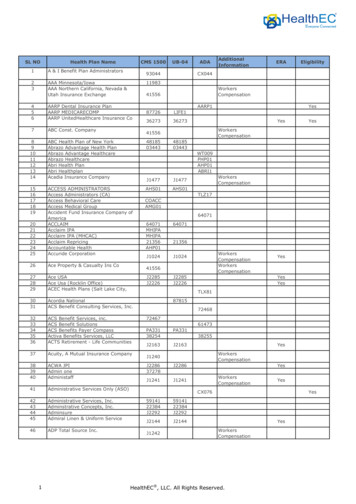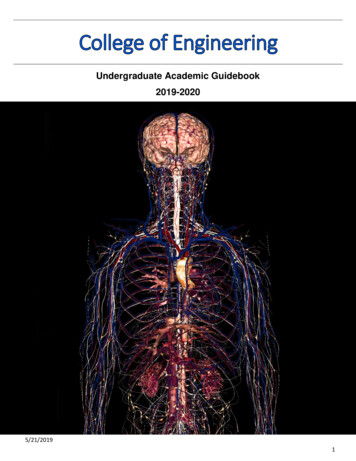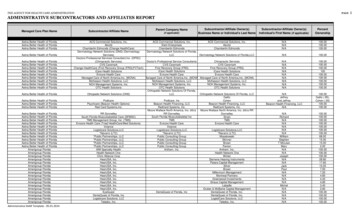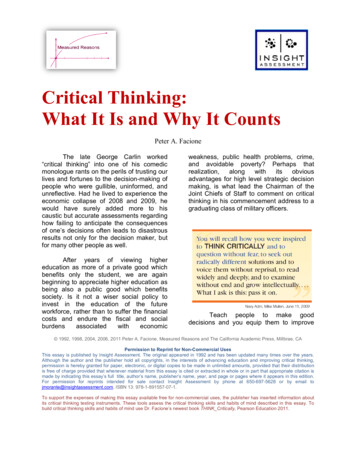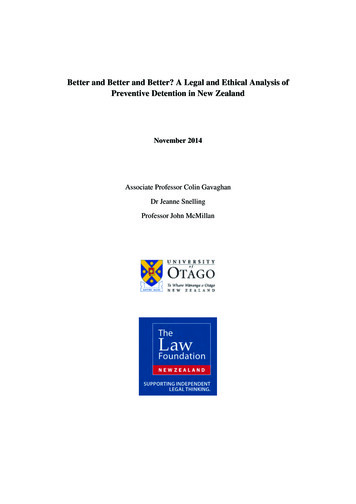
Transcription
Better and Better and Better? A Legal and Ethical Analysis ofPreventive Detention in New ZealandNovember 2014Associate Professor Colin GavaghanDr Jeanne SnellingProfessor John McMillan
The first words in this title, “Better and Better and Better”, are borrowed from adiscussion between Alice and the Queen of Hearts in the Lewis Carroll novel,Through the Looking Glass. The conversation concerned the concept of “livingbackwards,” and the possibility of punishing people for crimes that had not yet, andmay never, occur. In the Queen’s words, punishment for wrong-doing makes peoplebetter, but if the crime in question never occurs, that is “better still; better, and better,and better!” Through the Looking Glass, in The Complete Illustrated Works of LewisCarroll (Chancellor Press, 1982) 171.This report may be cited as:C Gavaghan, J Snelling and J McMillan Better and Better and Better? A Legal andEthical Analysis of Preventive Detention in New Zealand (Report for the NewZealand Law Foundation, University of Otago, 7 November 2014).1
AcknowledgementsThe authors would like to acknowledge the generous support of the New Zealand LawFoundation in sponsoring this project. We would also like to thank the variousparticipants in the October 2013 workshop which led to the Select Committeesubmission, and identified issues and questions for the Report. In particular, we wouldlike to thank Professor Bernadette McSherry, Dr Armon Tamatea and Kris Gledhillfor sharing their time and expertise. Thanks are also due to our current and formerstudents Phoebe Harrop and Amir Bastani for their contributions to this project.2
PrefaceThis report is the outcome of an independent, multidisciplinary review of theGovernment’s decision to introduce post-sentence detention into New Zealand via itsproposed Public Safety (Public Protection Orders) Bill (PPO Bill). The proposedregime is contentious because it permits, subject to specified criteria, the ongoing andindefinite detention of an offender after that individual has already completed thesentence originally imposed by the sentencing court.The research project, which was made possible by funding from the New ZealandLaw Foundation, consisted of three phases. The initial phase involved a meeting inOctober 2013, which brought together academics and practitioners from the fields oflaw, ethics, psychology and psychiatry. Presentations were given on varying aspectsarising from the proposed regime. These included presentations by ProfessorBernadette McSherry, an expert on post-sentence preventive detention regimes inAustralia, as well as Dr Armon Tamatea, formerly a Senior Advisor for PsychologicalResearch, Rehabilitation and Reintegration Services, New Zealand Department ofCorrections, and currently a senior lecturer in clinical psychology at the University ofWaikato.An outcome of this meeting was a joint submission made to the Justice and ElectoralSelect Committee on the PPO Bill, which was supported by all of those who attendedthe October meeting. Associate Professor Colin Gavaghan, Professor John McMillan(Principal Investigators) and Dr Armon Tamatea provided oral evidence to the Justiceand Electoral Select Committee on the PPO Bill in November.The final phase of the research involved drafting a more detailed report. As well asaddressing the questions raised at the Workshop about the proposed PPO regime, itwas decided that this would provide a broader overview of the trend towards‘preventive justice’ in New Zealand, and an evaluation of the issues and concernswhich this raises. This is that report.3
entiveDetention.9C.IncreasingSentencesandnon- 5Risk- Civilorcriminal inguishingthePurposeofActuarialTools:NZ’s(RoC ctiveFunction.66C.Principle- .884
I. IntroductionThe current political focus on Law and Order, in particular the imposition of harsherpenalties for serious crimes, is not a new governmental concern in New Zealand, noris it a partisan issue 1 Measures by both Labour and National-led coalitiongovernments over the last decade and a half have sought to address perceiveddeficiencies in the Criminal Justice system, particularly with respect to the roleascribed to victims in legal processes and to the length of custodial sentences imposedfor serious crimes.2This can, in part, be traced to events preceding the 2002 sentencing and parolereforms, which included a Law and Order petition that was successful in forcing acitizens initiated referendum in 1999.3 The referendum asked:4should there be a reform of our justice system placing greater emphasis on theneeds of victims, providing restitution and compensation for them and imposingminimum sentences and hard labour for all serious violent offences?The overwhelming response of voters was “yes”.5 Since then, successive amendmentshave been made to the Sentencing Act 2002 and the Parole Act 2002 that, together,replaced the Criminal Justice Act 1985.6 While some of these amendments haveintroduced flexible and arguably creative sentencing options for some types ofoffending (such as restorative justice and sentences of home detention), there has also1For example, Edwards notes that despite the Labour-led coalition governments significant penalreform measures, opposition parties in the 2008 election year campaigned strongly on anti-crimemeasures. See B Edwards “New Zealand” (2009) 48 European Journal of Political Research 1052 at1058. Law and Order was very much on the political agenda also in the 2011 elections—indeed thecurrent Public Safety (Public Protection Orders) Bill was one of the 2011 National party electionpromises.2In 1997 the Ministry of Justice released an impressive document to engage public discussion on therange of principles that underpin sentencing procedures. See Ministry of Justice Sentencing Policyand Guidance: A Discussion Paper (Ministry of Justice, New Zealand, Wellington, 1997).3The petition was initiated by Norm Withers whose 70 year-old mother was badly beaten in 1997while working in her son’s shop.4See Citizens Initiated Referendum (Appointed Day) Order (No. 2) 1999.5At the election 1,663,755 voted “yes” with just 147,009 voting “no”. As John Pratt has pointed out,however, the referendum received criticism for conflating several different questions and allowing onlyone answer; A Punitive Society: Falling Crime and Rising Imprisonment in New Zealand (BridgetWilliams Books, 2013).6Section 8 of the Sentencing Act requires the Court to take into account and information provided tothe court regarding the effect on the victim when sentencing an offender.5
been a very apparent trend of progressively increasing custodial penalties for seriouscriminal offences. 7 The cumulative effect of these measures has led John Pratt,professor of criminology at Victoria University, to claim that:8From the early 1990s to the present, the rate of imprisonment here [in NewZealand] has moved from being merely on the high side of the western norm tobeing a complete outlier.In addition to the trend towards longer sentences, though, recent years have seen anincreasing trend towards what has been labelled “preventive” or “protective” justice.9The “preventive” or “protective” justice concept is distinguishable from traditionalretributive accounts of the criminal law. The traditional approach is premised on theview that the criminal justice system derives its legitimacy as a result of imposingpunishment that is in response and in proportion to the offender’s culpability for actsalready carried out.10 Preventive justice, in contrast, is forward-looking and riskoriented, concerned less with what the offender has already done, than with what he isthought likely to do in future.The ready appeal of such an approach is not hard to understand. Measures designed toprotect some of the most vulnerable members of society from some of its mostdangerous members are likely to command popular support. Seen against a backdropof increasing “penal populism”,11 and increasing demands on governments to keep us“safe”, it is easy too to understand the political impetus behind proposals to detaindangerous criminals until society can be assured of their safety.7The sentences that may be imposed under the Act, from least to the most restrictive are: “(a)discharge or order to come up for sentence if called on: (b) sentences of a fine and reparation: (c)community-based sentences of community work and supervision: (d) community-based sentences ofintensive supervision and community detention: (e) sentence of home detention: (f) sentence ofimprisonment.” Sentencing Act 2002, s 10A.8J Pratt A Punitive Society: Falling crime and Rising Imprisonment in New Zealand (Bridget WilliamsBooks, 2013) at 9.9For example see A Ashworth, A Lee and L Zedner “Oxford Preventive Justice Project” University ofOxford, Faculty of Law www.law.ox.ac.uk .10SJ Morse “Blame and Danger: An Essay on Preventive Detention” (1996) 76 Boston UniversityLaw Review 113 at 121 citing P Robinson “Foreword to the Criminal-Civil Distinction and DangerousBlameless Offenders” (1993) 83 Criminal Law & Criminology 693 at 706-708.11Pratt A Punitive Society at chapter 4.6
In addition, while the retributive approach to criminal justice can sometimes appear tobe premised on rather archaic ideas of blame and punishment, the “preventive”approach often appears to be informed by rational concerns and scientificallyinformed techniques of risk-assessment. This aspect goes some way to explaining thesupport for such initiatives not only among the expected “tough on crime”conservative constituency, but frequently too among those who may be consideredmore socially progressive.12 Finally, as we explore in Part V, the government is notonly morally and politically, but also legally obligated to take steps to protect itscitizens from danger.As we discuss in this report, though, there may well be reasons to be concerned aboutthe trend towards preventive justice. Some of these have to do with the possibility thatpredictions of future dangerousness may be mistaken; in Part IV, we evaluate theaccuracy with which such predictions can presently be made. Others relate to thevarious practical consequence of preventive initiatives. Clearly, if these are unlikelyto be effective in reducing risk, then their principal rationale is undermined. A thirdclass of concerns relate to the compatibility of preventive measures with NewZealand’s domestic and international human rights obligations.At the heart of concern about preventive initiatives, though, there are also issues ofprinciple, and in particular, a fear that the increasing trend towards preventive justiceimperils a basic building block of our ideas of justice. When we depart from aparadigm concerned largely with blame for past actions, and embrace instead aparadigm wherein the state can detain people based on predicted future actions,something quite fundamental may have shifted in our society. Identifying preciselywhat that something may be is a task we undertake in Part V.The Public Safety (Public Protection Orders) Bill, which is the principal focus of thisreport (and which we discuss at length in Part III), represents a significant step in thedirection of preventive justice. It should be clear from the outset, though, that it is byno means a first step in that direction – either for New Zealand, or internationally.12See, for example, the explicitly feminist support for the Public Safety (Public Protection Orders) Billat its first reading from Labour MP Sue Moroney; (18 September 2013) 693 NZPD at 13480.7
Rather, New Zealand is already some way down that road. In Part II, we evaluate thesteps that have already been taken towards – and in a few cases, back from – apreventive model of justice.At the time of writing, the PPO Bill has already had a second reading in Parliament.By the time of publication, it may already be law. It is our hope, nonetheless, that thisreport presents an opportunity to pause and to consider how much further we, as asociety, should travel down that particular road.8
II. A Trend Toward “Preventive” Justice in NZA. IntroductionThe move towards “preventive” justice may have accelerated in recent years, but itwould be a mistake to regard it as a novel phenomenon. In New Zealand, a range ofoptions are already available to the state to prevent convicted persons fromcommitting potential future criminal acts, ostensibly justified on the grounds that theyare necessary to secure the safety of the wider public. These include the judicial andstatutory trend toward imposing lengthier sentences for serious crimes, sentences ofPreventive Detention, Extended Supervision Orders and the “three strikes” legislationintroduced in 2010. The following analysis examines the scope of the regimes, theprescribed risk-threshold for imposition of the various mechanisms, and the expertevidence that is used in judicial determinations in respect of each of these regimes.In this Part of the report, we are concerned with preventive initiatives that are at leastquasi-criminal in nature; that is, they are either imposed as part of a punitive sentence,or are triggered by a criminal conviction. The broader “preventive project”, however,also includes various civil schemes, which need have no connection to the criminaljustice system at all. Some of those will be considered later in the report.B. History of Preventive DetentionPreventive detention is the sentencing of an offender to an indeterminate, or “nonfinite” sentence. Its origins in New Zealand may be traced back to the HabitualCriminals and Offenders Act of 1906, which authorised the court to impose a nonfinite reformative sentence of detention following a finite prison term.13The Criminal Justice Act 1954 introduced the actual sentence of preventive detentioninto New Zealand for the first time.14 In its original form, preventive detention wasavailable for three categories of offender over the age of twenty-five years: repeatminor offenders; repeat middle range offenders; and sexual offenders against children13Ministry of Justice Sentencing Policy and Guidance: A Discussion Paper (Ministry of Justice, NewZealand, Wellington, 1997) at 108 citing P Webb A History of Custodial and Related Penalties in NewZealand (Government Printer, Wellington, 1982) at 19-25.14Criminal Justice Act 1954, s 75.9
with at least one prior similar conviction. The seriousness of the past or currentoffending reduced the number of previous offences and sentences required foreligibility. The criterion for imposition of the sentence was whether the High Courtwas “satisfied that it was expedient for the protection of the public that the offendershould be detained in custody for a substantial period.”15Preventive detention as such was abolished in 1967, except for persons qualifying byreason of sexual offending (which included child sexual offending). One of thereasons given by the incumbent Minister of Justice for repealing the provisions “wasthe inappropriateness of preventive detention for offenders whose record, though long,did not make them a menace to society.”16 Additional reasons included the “stressesassociated with an indeterminate sentence, and the difficulty of deciding when releasewould be justified”.17 The sentence of preventive detention has since focused morenarrowly on violent and sexual offenders considered likely to pose further seriousharm. In 1993 the Criminal Justice Act 1985 was amended to permit the court toimpose a sentence of preventive detention with a non-parole period greater than 10years in “exceptional” cases.18Later in 1999, the Ministry of Justice noted the issues associated with “protective”sentencing in its Sentencing Policy and Guidance: A Discussion Paper. 19 Itspecifically acknowledged the problems associated with sentencing people to periodsof imprisonment that are disproportionate to their offending, on the basis ofpredictions of their likelihood of committing dangerous offences in the future. It notedacademics von Hirsch and Ashworth’s arguments that it:2015Section 75.16Ministry of Justice Sentencing Policy and Guidance: A Discussion Paper (Ministry of Justice, NewZealand, Wellington, 1997) at citing P Webb A History of Custodial and Related Penalties in NewZealand (Government Printer, Wellington, 1982) at 74 (emphasis added).17Ministry of Justice Sentencing Policy and Guidance citing P Webb A History of Custodial andRelated Penalties in New Zealand (Government Printer, Wellington, 1982) at 74.18Criminal Justice Amendment Act 1993.19Ministry of Justice Sentencing Policy and Guidance: A Discussion Paper (Ministry of Justice, NewZealand, Wellington, 1997).20At 117, and at 62 citing A Von Hirsch and A Ashworth (eds) Principled Sentencing (NortheasternUniversity Press, Boston, 1992) at 104.10
is especially problematic because of the difficulty of predicting offending,and the added difficulty in predicting serious violence due to the relative rarity ofsuch events. The 1981 Floud Report’s conclusion that the prediction ofviolent offending has at best a 50 per cent success rate appears to still hold true.21This level of accuracy is well below the normal standard of proof for a criminalconviction that is proof beyond reasonable doubt.Furthermore, protectivesentencing on the basis of predictions of future behavior runs counter to thefundamental right to be presumed innocent until proven guilty. In fact it createsthe reverse presumption.In effect, protective sentencing deprives certainindividuals of rights basic to our criminal justice system.This departure from the standard principles [sic] is advocated on the basis of therisk of extreme harm which these offenders are seen to pose. The fact that theseoffenders have shown through past behavior that they are capable of, or highlylikely to carry out, extremely harmful actions justifies tipping the balance awayfrom the offenders’ rights and towards the rights of their potential victims. Thispublic protection balance has been clear in the courts’ exercise of the discretionto impose preventive detention on eligible offenders . (emphasis added).In the abstract above, the Ministry of Justice considered both the principles offorfeiture (whereby the offender “forfeits” their usual rights to liberty) on the basis ofthe correlative rights of members of the public to be protected from dangerouspersons. However, the paper acknowledged the difficulty of balancing rights-claimsbased on mere prediction. It continued to quote Von Hirsch and Ashworth that:22Each society must make a moral decision as to how far to tip the balancebetween the rights of the offender not to be put at risk of excessive confinementthrough inaccurate predictions, and the rights of potential victims to be protectedfrom convicted offenders who are assessed as likely to commit further verydangerous offences.In making such decisions it must be recognized thatdangerous offences are also committed by people who have not previously beenconvicted, or whose previous convictions have not led to suggestions that theybe considered for protective sentencing. There is, nevertheless, a reasonable21J Floud and W Young Dangerousness and Criminal Justice (Heinemann, London, 1981).22Ministry of Justice Sentencing Policy and Guidance at 117 and at 62, citing Von Hirsch and AAshworth (eds) Principled Sentencing (Northeastern University Press, Boston, 1992) at 104.11
degree of consensus as to the need for some type of protective sentencingprovisions.Despite accepting that some type of protective sentencing is justified on moralgrounds, the Ministry nevertheless considered that issues regarding eligibility,prediction methods and accuracy made a strong case for “substantial proceduralprotections of the rights”23 of those considered for protective sentences. This is agiven if one considers that it involves curtailing an individual’s liberty “merelybecause people like him or her will offend again, [when] we cannot specify whichof them will actually do so”.24C. Increasing Sentences and non-Parole PeriodsDespite the repeal of habitual offender legislation, and the reduced scope ofpreventive detention in the 1960s, preventive detention in various forms has beenexpanding incrementally in New Zealand over the last decade and a half. One subtlemeans by which this has been achieved is by the imposition of lengthier minimumsentences of imprisonment for defendants convicted of serious crimes, as a result ofjudicial discretion and statutory amendments.When sentencing William Bell and his co-defendant in 2003 after the infamousReturned Services’ Association (RSA) murders, Potter J noted an apparent trend inincreasing sentences in the case of serious violent crimes. One expert to provideevidence in R v Bell and Tupe25 was a psychologist who informed the court that Bell’sprofile closely matched that of the “proto-typical psychopath”, elaborating:26It is clear that Mr Bell has habitually engaged in increasingly serious predatoryoffending since early adolescence his offending has been planned as well asopportunistic and has been motivated by greed as well as by revenge motives.The laviscious [sic] even sadistic nature of his violence points to underlying rage23At 118.24Von Hirsch and A Ashworth (eds) Principled Sentencing (Northeastern University Press, Boston,1992) at 104 cited in The Ministry of Justice Sentencing Policy and Guidance: A Discussion Paper(Ministry of Justice, New Zealand, Wellington, 1997) at 62.25R v Bell and Tupe (Unreported HC, Auckland T.020505, 13 February 2003, Potter J).26At [44]. For a thorough discussion of the challenges psychopathy poses for the law see AR Fox, THKvaran, and RG Fontaine “Psychopathy and Culpability: How Responsible Is the Psychopath forCriminal Wrongdoing?” (2013) 38 Law & Social Inquiry 1-26.12
and motives of revenge easily kindled in Mr Bell who is unable to bear criticismor even the slightest rejection.The psychological dynamic is supported bysubstance abuse, lack of empathy and remorse and would be very difficult tochange even if Mr Bell had some insight and were motivated and able to engagein treatment.The expert opinion suggested that Bell’s psychological profile identified him as anintractable offender. Significantly, however, the court observed that: “[t]o theextent that the psychiatric reports attempt to assess the risk of future offending,they are relevant documentation for the purposes of the Parole Board, rather thanfor sentencing.”27 This was because, although Bell would qualify for a sentence ofPreventive Detention under the Sentencing Act 2002, he was subject to theprovisions of the Criminal Justice Act 1985 that provided a lesser penalty.28Given the circumstances of the offence, the presumption in favour of lifeimprisonment for murder applied.The issue therefore was the length of theminimal non-parole period to be imposed.A minimum sentence of 10 years was generally applicable. However theSentencing Act 2002 permitted the Court, if satisfied that the circumstancessurrounding the offence were "sufficiently serious",29 to impose a greater minimumparole period.30 That minimum period of imprisonment was what “the Courtconsiders to be justified, having regard to the circumstances of the case includingthose of the offender.”31In considering the appropriate minimum period of imprisonment, the court reviewedthe sentencing decisions in R v Bain32 and R v Lundy.33 Both cases involved multiple27R v Bell and Tupe (Unreported HC, Auckland T.020505, 13 February 2003, Potter J) at [46].28Section 6 of the Sentencing Act conferred on an offender the right, if convicted of an offence forwhich the penalty has been varied since the offence was committed to have the benefit of the lesserpenalty when sentenced. This is consistent with the New Zealand Bill of Rights Act 1990.29Section 103(3). This is defined as being “out of the ordinary range of offending of the particularkind”.30Section 103(3) was repealed by the Sentencing Amendment Act 2004.31R v Bell and Tupe (Unreported HC, Auckland T.020505, 13 February 2003, Potter J) at [56].32R v Bain (Dunedin High Court, T.l/95, 21 June1995).13
murders where the seriousness of the offending was found to justify imposing longerthan usual non-parole periods. In R v Lundy the Court of Appeal held that theseriousness of the offences justified a non-parole period of 20 years.34 This wasaccompanied by the Court’s observation that, since R v Bain (in which the courtimposed a non-parole sentence of 16 years) society’s “attitude to very serious violentcrime has hardened”.35 Although not noted by the Court, when Bain was sentenced in1999 a judge was only authorized to impose a minimum non-parole period in“exceptional circumstances”, which was subsequently amended to the broader“sufficiently serious” test.The court made a similar reference to public opinion justifying longer sentences in thecase of R v Watson.36 In Watson the court imposed a 17-year sentence without paroleon a convicted double murderer, noting that the crimes “have outraged the public ofNew Zealand”.37 Ultimately, Bell was sentenced to imprisonment for life and a 33year non-parole period imposed. His subsequent release after that time is for theparole board
Through the Looking Glass. The conversation concerned the concept of "living backwards," and the possibility of punishing people for crimes that had not yet, and may never, occur. In the Queen's words, punishment for wrong-doing makes people . the referendum received criticism for conflating several different questions and allowing only .
